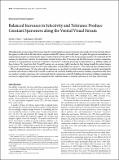| dc.contributor.author | DiCarlo, James | |
| dc.contributor.author | Rust, Nicole C. | |
| dc.date.accessioned | 2013-02-06T17:18:07Z | |
| dc.date.available | 2013-02-06T17:18:07Z | |
| dc.date.issued | 2012-07 | |
| dc.date.submitted | 2012-04 | |
| dc.identifier.issn | 0270-6474 | |
| dc.identifier.issn | 1529-2401 | |
| dc.identifier.uri | http://hdl.handle.net/1721.1/76751 | |
| dc.description.abstract | Although popular accounts suggest that neurons along the ventral visual processing stream become increasingly selective for particular objects, this appears at odds with the fact that inferior temporal cortical (IT) neurons are broadly tuned. To explore this apparent contradiction, we compared processing in two ventral stream stages (visual cortical areas V4 and IT) in the rhesus macaque monkey. We confirmed that IT neurons are indeed more selective for conjunctions of visual features than V4 neurons and that this increase in feature conjunction selectivity is accompanied by an increase in tolerance (“invariance”) to identity-preserving transformations (e.g., shifting, scaling) of those features. We report here that V4 and IT neurons are, on average, tightly matched in their tuning breadth for natural images (“sparseness”) and that the average V4 or IT neuron will produce a robust firing rate response (>50% of its peak observed firing rate) to ∼10% of all natural images. We also observed that sparseness was positively correlated with conjunction selectivity and negatively correlated with tolerance within both V4 and IT, consistent with selectivity-building and invariance-building computations that offset one another to produce sparseness. Our results imply that the conjunction-selectivity-building and invariance-building computations necessary to support object recognition are implemented in a balanced manner to maintain sparseness at each stage of processing. | en_US |
| dc.description.sponsorship | National Eye Institute (Grant 1F32EY018063) | en_US |
| dc.description.sponsorship | National Eye Institute (Grant R01EY014970) | en_US |
| dc.description.sponsorship | McKnight Endowment Fund for Neuroscience | en_US |
| dc.language.iso | en_US | |
| dc.publisher | Society for Neuroscience | en_US |
| dc.relation.isversionof | http://dx.doi.org/10.1523/jneurosci.6125-11.2012 | en_US |
| dc.rights | Article is made available in accordance with the publisher's policy and may be subject to US copyright law. Please refer to the publisher's site for terms of use. | en_US |
| dc.source | SFN | en_US |
| dc.title | Balanced Increases in Selectivity and Tolerance Produce Constant Sparseness along the Ventral Visual Stream | en_US |
| dc.type | Article | en_US |
| dc.identifier.citation | Rust, N. C., and J. J. DiCarlo. “Balanced Increases in Selectivity and Tolerance Produce Constant Sparseness Along the Ventral Visual Stream.” Journal of Neuroscience 32.30 (2012): 10170–10182. | en_US |
| dc.contributor.department | Massachusetts Institute of Technology. Department of Brain and Cognitive Sciences | en_US |
| dc.contributor.department | McGovern Institute for Brain Research at MIT | en_US |
| dc.contributor.mitauthor | DiCarlo, James | |
| dc.contributor.mitauthor | Rust, Nicole C. | |
| dc.relation.journal | Journal of Neuroscience | en_US |
| dc.eprint.version | Final published version | en_US |
| dc.type.uri | http://purl.org/eprint/type/JournalArticle | en_US |
| eprint.status | http://purl.org/eprint/status/PeerReviewed | en_US |
| dspace.orderedauthors | Rust, N. C.; DiCarlo, J. J. | en |
| dc.identifier.orcid | https://orcid.org/0000-0002-1592-5896 | |
| mit.license | PUBLISHER_POLICY | en_US |
| mit.metadata.status | Complete | |
